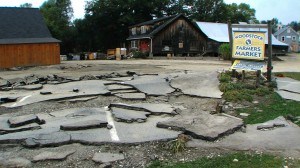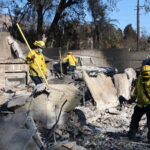Vermont state engineers and scientists said that more than 300 river banks, bridges and other sites damaged by Tropical Storm Irene still need repairs – some to fix repairs done the wrong way after the storm.

Officials from the state agencies of Transportation and Natural Resources gathered Tuesday afternoon near a bridge along Route 12A in Braintree to talk about a second post-Irene fix needed there.
“We don’t want to have to rebuild this every time,” said Justin Johnson, deputy commissioner of the Department of Environmental Conservation.
Of the repeat repairs, he said, “None of this is a surprise. It was fully expected that we’d be back a second time,” to many locations around the state.
With feverish work under way around Vermont last fall to fix roads washed out by the Aug. 28 storm, shortages of materials meant many jobs were done without the best materials.
For example: the rock used to reinforce the White River’s bank just before it flows under the bridge was small enough that it is likely to be swept away by the next flood.
The fix, said Chris Cole, director of planning at the Transportation Agency, will be larger stones laid in a more concave shape, to accommodate the natural flow of the stream.
Agency of Transportation officials released figures showing there are 359 sites around Vermont damaged by Irene that are considered stable now, meaning those repairs should stand indefinitely.
Another 323 sites need more work, ranging from road sections that got temporary fixes after the storm and need permanent ones to places where dredging some towns did in river channels after floods needs to be filled back in.
Neighbor Philip Farnsworth, who lives across a road and railroad, stood nearby, watching Tuesday’s proceedings. Farnsworth said he favored dredging in rivers, to give floodwaters more room and to create deeper pools for fish.
But Todd Menees, a river management engineer with the environmental agency, said that’s the wrong approach.
He and other officials said the best brake on flooding is to allow a river room to have its energy absorbed into adjacent wetlands. They also said dredging can undermine river banks, adjacent roadways and other structures.
Johnson said he did not believe anyone should be faulted for work done after the storm, as the state and town road crews scrambled to make repairs.
“It was pretty rough and ready, doing what they could to get roads open,” he said.
State officials said they did not know how much the remaining repairs would cost, but the said federal funding would be available for about 80 percent of the projects.
Was this article valuable?
Here are more articles you may enjoy.

 Trump’s Tariffs Threaten to Endanger the Cheap American Car
Trump’s Tariffs Threaten to Endanger the Cheap American Car  New Fire Maps Put Nearly 4M Californians in Hazardous Zones
New Fire Maps Put Nearly 4M Californians in Hazardous Zones  Scammers Are Pushing Auto Loan Fraud to Record Levels
Scammers Are Pushing Auto Loan Fraud to Record Levels  Ticketmaster May Have Broken Law With ‘Platinum’ Oasis Seats
Ticketmaster May Have Broken Law With ‘Platinum’ Oasis Seats 